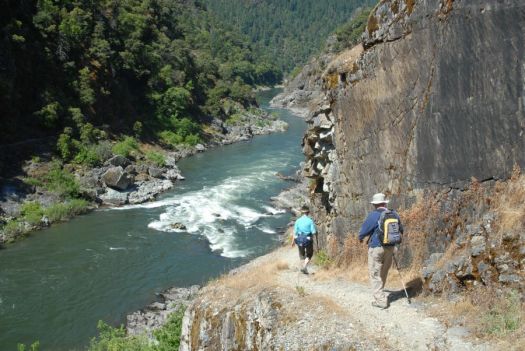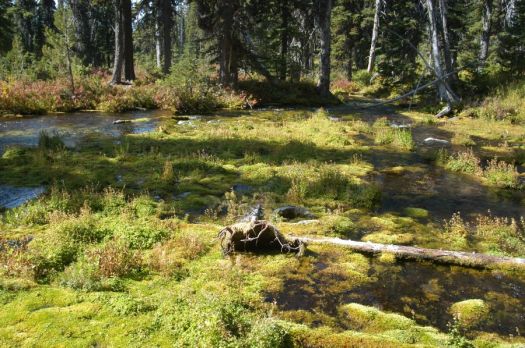

 Spring '24 Issue - Best Of Winners Announced & More
Spring '24 Issue - Best Of Winners Announced & More 
Monday, October 20, 2014
Enjoying Southern Oregon's Wilderness Areas
Get Out and Go
Enjoying Southern Oregon's Wilderness Areas
Story by Lee Juillerat
It was Friday afternoon and, because I had worked extra hours earlier in the week, I decided to hustle home, load up my backpack and head for the hills. Less than two hours later I was at the trailhead, ready to hike and escape for two nights in the Mountain Lakes Wilderness.
Most backpack trips are better thought out. But, thanks to forward thinking by advocates for a national wilderness system, one of the major decisions for Southern Oregonian hikers and backpackers is which wilderness to visit.
Whether for a few hours, an overnight or several nights, slipping off to an area where there are no motorized vehicles offers a chance to recharge and be revived.
It was 50 years ago—September 3, 1964—when President Lyndon B. Johnson signed the Wilderness Act, legislation that had gone through 60 drafts over an agonizing eight-year period. Virtually overnight, 9.1 million acres were set aside where, as the Act declares, “man himself is a visitor who does not remain.”
Mountain Lakes was among the original 1964 wilderness areas. It's also unique because it's the nation's only with borders that form a perfect square. Also established in 1964 were the Kalmiopsis, Diamond Peak and Gearhart wildernesses and, just south of the Oregon-California state line, the South Warner and Marble Mountain.
Just as the wilderness system has expanded to nearly 110 million acres nationally, so have the number of wilderness areas in Southern Oregon. Over the years the additions have included Sky Lakes, Wild Rogue, Rogue Umpqua Divide, Soda Mountain, Red Buttes, Copper Salmon and Grassy Knob.
That's why picking where to go can be a challenge.
Sky Lakes, which like many others received wilderness designation in 1984, is a popular and easy-to-access destination. It follows the Cascades crest from Highway 140 to Crater Lake National Park's south boundary, with portions in Jackson and Klamath counties. It's easy to hike into a bucolic lake for the day in-and-out from either the west or east side. The area features lakes for swimming, fishing and relaxing. One trail leads to the headwaters of the Rogue River, another to the fantastic Ranger Spring. The northern end offers tumbling Stuart and Red Blanket Falls.
It's easy to plan a multi-day backpack from south to north along the Pacific Crest Trail or, even better, drop off the PCT to lesser-traveled trails that meander through lake basins. For people who enjoy combining hiking and history, there's Island Lake with the Waldo Tree. In September 1888, after traveling two months along the Cascades, a member of the exploration party led by Judge John B. Waldo carved the party's names into the still-standing mountain hemlock.
The Sky Lakes Wilderness is dominated by the pyramid-shaped Mount McLoughlin. Its lofty 9,495-foot summit is also a relatively straightforward, non-technical climb done by hikers of all ages.
Located just north of Crater Lake National Park is the Mount Thielsen Wilderness. It lure is its rugged 9,182-foot namesake peak, nicknamed "The Lightning Rod of the Cascades" because of frequent lightning strikes.
Offering an entirely different perspective is the Kalmiopsis Wilderness, another 1964 wilderness. Characterized by deep canyons, clear mountain streams and a diversity of plants, the area is named for Kalmiopsis leachiana, a slow-growing plant related to the rhododendron, which was discovered in the area in 1930.
Rising above the high desert country of Klamath and Lake counties is the distinct Gearhart Mountain Wilderness, for many years regarded the nation's least visited, not because it lacks appeal but because of its relative remoteness. Among its attractions is The Palisades, a several acre area with a fascinating, oddly stacked rock formation, and (truly) Blue Lake.
The Wild Rogue Wilderness surrounds the Wild and Scenic Rogue River. The Soda Mountain Wilderness lies within the Cascade-Siskiyou National Monument, another area known for its biological diversity. The Red Butte Wilderness follows the crest of the Siskiyou Mountains into California while the Grassy Knob Wilderness, with very few established trails, is known for its solitude and towering old growth Port Orford cedar and Douglas fir. The Cooper Salmon features one of the nation's largest remaining stands of old-growth forests and healthy salmon, steelhead and cutthroat trout runs.
Several wildernesses are just south of the state line, including two that were among the original wilderness areas created by the 1964 Wilderness Act, the South Warner and Marble Mountain wildernesses.
The seldom-visited South Warner Wilderness is relatively remote in far northern California's Modoc County. From the Summit Trail, views west include dry alkali lakes in Surprise Valley and, further out, the Hayes Range in Nevada.
Recently, just because for some undefined reason I'd never been there, I spent three days in the Marble Mountains, another 1964 wilderness, which rise east of Yreka in Siskiyou County. The area gets its name from the distinctive coloration caused by light-colored limestone and black metamorphic rock on some peaks that give the mountains a marbled appearance.
During my visit I peeked into cabins that pre-date the establishment of wilderness, and climbed up and over drainages to lake-filled basins. Some trails crossed creeks so tiny I gently stepped across, others I tippy-toed over on strategically placed rocks, and one so wide and deep I simply left my boots on and waded through its thigh-deep waters.
As I was reminded in the Marbles, the choices of where to go, whether it's which trail or which wilderness, are many. And, as I relearned, sometimes the best choice is just to get up and go—and enjoy.
Events & Promotions
Apr
26
Apr
27
Apr
28
Central Point
Charlee Prayers & The Double Dares play Rellik
Charlee Prayers & The Double Dares play Rellik
Apr
29
May
03
Gold Hill
Del Rio Vineyard Dinner in the Vineyard Spring edition OREGON FEAST
Let's celebrate Oregon Wine Month. Join us for an evening of wine ...













